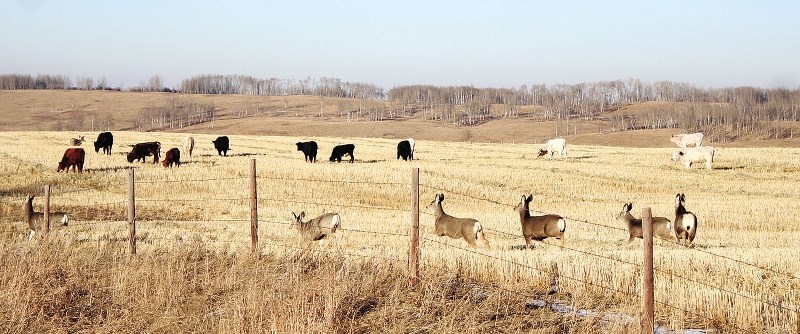While too premature to declare the ‘D word’ (drought) there is little doubt that the lower than average precipitation levels will impact those in the agriculture industry this year.
“It’s anybody’s guess what will happen this year,” said area cattle rancher and hay producer, Gordon Fike, adding that while his pastures (north of Cochrane) have had some rain this year, he is aware that the situation has been more dire along the northern and eastern areas of the province and that grain prices have already begun to climb.
Area cattle producer, Erik Butters, said the good news is that cattle prices are strong at the moment.
“It’s not a price disaster by any means,” said the former chair of the Alberta Beef Producers and current MD of Bighorn deputy reeve.
“There’s plenty of time to panic,” he laughed, adding that if rain arrives for the last half of July, there is still time to recover.
If the heat wave continues, it’s likely that those planning to yield a second crop of hay may be unable to do so; that those who haven’t been able to circulate their cattle between pastures may run into an overgrazing situation; and that the grasshopper infestation risk (already severe to very severe in some central and southern regions of the province) will continue to rise.
For those producers looking to produce two crops this season (most Cochrane area producers yield one crop) the essential time for rain is now — as most should have taken their first crop by the end of June/beginning of July and would require rain for their second crop to take seed (to be harvested some 4-6 weeks later).
Mark Cutts is a crop specialist with Alberta Agriculture and Forestry.
“While there are some areas with decent crops, hay land production has been substantially reduced, as has pasture land,” said Cutts, adding that it’s key for producers to be ‘creative’ under these circumstances — to rotate grazing cattle on pastures more quickly, possibly locate additional pastures and to prevent overgrazing, as lands take even longer to recover from been overgrazed during seasons with little rain.
Cutts said that while it’s early in the season, the trend is that hay prices will be higher this year, as will grain prices.
With respect to the grasshopper forecast for 2015, some areas between central and southern Alberta have been identified as high to severely high risk areas; areas identified with the most notable grasshopper population increases this year are the areas of Forty Mile and Willow Creek — but that other areas of Southern Alberta (around Lethbridge and Medicine Hat) may have cause for alarm.
“Producers are probably making decisions right now on whether to spray or not,” said Cutts, explaining that grasshopper problems are the result of a build-up over time.
Infestation of crops by grasshoppers can lead to costly crop devastation if not managed.
While Cochrane and surrounding areas have been identified as low-risk areas, the problem in other areas of the province could also contribute to spiking hay and grain prices this fall.
According to Bill McMurtry, meteorologist with Environment Canada, Calgary and area (Cochrane) is sitting around 75 per cent of normal precipitation levels — whereas areas along the northern and eastern portions of the province, from Lloydminster through Brooks and east of Medicine Hat, are sitting around 40 per cent.
“The good news is that we’re seeing a change in weather patterns (in the short term),” said McMurtry, adding that rainfall is slated today through the weekend in many areas across the province, with some areas estimated to receive around 25 mm of precipitation in that time frame.
He added that there is a seasonal return to temperatures in the low-mid 20s next week.
While weather models have improved over years, the most accurate predicting is the seven-day forecast, with increased accuracy with 30-day weather models.
Technology has not advanced enough to accurately detect longer-term weather models.
McMurtry said there are little commonalities between summer and winter weather patterns and that fall would be a better indicator of what winter 2015/16 has in store.




